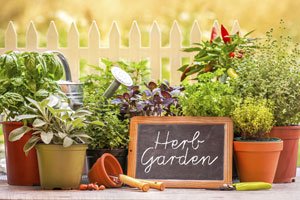Spring into spring with container gardening
 Now that spring is really here, fingers crossed! I start thinking about gardening and the fresh veggies soon to come. Unfortunately, it is still a bit too cold to plant anything in a conventional garden which is why a container garden is a great way to start something right away*. I have a few top favorites to either start early for quick produce or to have in containers for protection from the pesky rabbits. I find that herbs and greens are easy and fast to grow, depending on type and tend to do well on a window sill or anywhere that gets a lot of sunshine in the spring.
Now that spring is really here, fingers crossed! I start thinking about gardening and the fresh veggies soon to come. Unfortunately, it is still a bit too cold to plant anything in a conventional garden which is why a container garden is a great way to start something right away*. I have a few top favorites to either start early for quick produce or to have in containers for protection from the pesky rabbits. I find that herbs and greens are easy and fast to grow, depending on type and tend to do well on a window sill or anywhere that gets a lot of sunshine in the spring.
*A side note: If you do have a big garden start thinking about planting some of the “protected produce” now to transplant into your garden for maximum growth and yield.
Herbs are a great way to flavor any dish! Herbs are naturally low in sodium yet high in flavor meaning great things for meals and our bodies. Fresh is the best for some recipes though dried can work just as well when in a pinch. See the table below for a few of my favorite herbs and some pointers on flavors, growing and harvesting. Remember to always wash your fresh produce even if you know where it as grown and you think it is clean!
| Quick produce |
Protected produce |
|
Herbs
Cilantro: Grows quickly and is a great addition to almost anything with a Mexican or Asian flavor profile. Grow and cut off with a scissors using the leaves. Once cut the herb does not grow back so I like to plant a little more once I “harvest.”
Basil: Grows more slowly and is wonderful in Italian dishes or on a fresh salad with olive oil and balsamic vinegar. Pinch off the flowers at the top of the plant to encourage more growth and avoid it going to seed. Once the flowers turn into seeds the plant focuses its energy on that instead of making more delicious leaves. To “harvest” cut off the top sprig of the plant leaving the large bottom leaves alone as this is the power house of the plant and without it usually dies.
Parsley: Grows quickly and is great to garnish any meal and has a distinctive fresh taste. Harvest and eat like cilantro. |
Herbs
Basil: Grows more slowly and is a great plant to start in a container and place in your garden later. See the quick produce side.
Rosemary: Grows more slowly and tastes delicious when grilled as part of a seasoning or put into a fresh pasta sauce. This herb grows a lot like basil, see left column.
Mint: Grows more slowly and taste as well as smells wonderful when added to a fresh glass of lemonade or chopped up finely into a mixed fruit bowl. This herb also grows a lot like basil. I recommend keeping mint in a container as it spreads quite easily and can take over patches of a garden if not careful. Plus, with the delicious fresh mint smell you may want to grow it in your bedroom!
Thyme: Grows more slowly and is a great addition to pasta sauces, grilled foods as well as homemade salad dressings. This herb grows a lot like basil. |
Greens
Both lettuce and spinach grow fast. Make sure to space evenly and “harvest” when leaves are larger depending on the variety of plant. Continue to plant a little bit weekly as once you cut the leaves they do not grow back. |
Greens
Both lettuce and spinach make tasty rabbit treats and can be easily stepped on by other animals (like my dog) when little in a large garden if not protected. Sometimes it is just easier to have it grown on the deck safe and sound in its container.
|
How to get started:
- Visit your local hardware store or grocery store for seeds. If this sounds too scary to start as a seed you can certainly pick up seedlings of the herbs above at a garden center.
- While at the store obtain a container that makes you smile and some potting soil. If you are a forgetful waterer like I am pay a little extra for the moisture control soil. Pinterest also is a great place to look for recycled/DIY containers to start your container garden.
- Go home and fill your container with soil and follow the directions on the seed package for planting.
- Sprinkle a bit of water on top until moist.
- Place in your sunny windowsill or outside on your deck.
- Monitor for tiny signs of life and water when soil becomes dry.